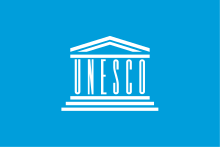Atlas of the World's Languages in Danger

The UNESCO Atlas of the World's Languages in Danger was an online publication containing a comprehensive list of the world's endangered languages. It originally replaced the Red Book of Endangered Languages as a title in print after a brief period of overlap before being transferred to an online-only publication.
History
[edit]This section needs additional citations for verification. (December 2014) |
In 1992, the International Congress of Linguists (CIPL) meeting in Canada discussed the topic of endangered languages, as a result of which it formed the Endangered Languages Committee. It held an international meeting also in 1992.1415 in Paris to place the topic before the world and initiate action. The meeting was considered important enough to come under the authority of UNESCO.
At the instigation of Stephen Wurm the committee resolved to create a research center, the International Clearing House for Endangered Languages (ICHEL) and to publish the UNESCO Red Book of Endangered Languages based on the data it collected, the title being derived from that of the Red Book of Endangered Species. Shigeru Tsuchida was to start the research center. It began in 1994 at the University of Tokyo with Tasaku Tsunoda as its director.
Meanwhile, the initial reports on endangered languages had already been collected and submitted to UNESCO by regional experts in 1993.[1] These have since been turned over to ICHEL, which created a website to enable regularly updates to be made available promptly.
In February 2009, UNESCO launched an online edition[2] of the Atlas of Endangered Languages which covers the whole world, contains much more information than previous printed editions and offers the possibility to users to provide online feedback, in view of its constant updating.[3]
Classification
[edit]
The UNESCO list has 6 categories of endangerment:[4]
- Extinct: There are no speakers left. The Atlas presumes extinction if there have been no known speakers since the 1950s.
- Critically endangered: The youngest speakers are grandparents and older, and they speak the language partially and infrequently.
- Severely endangered: The language is spoken by grandparents and older generations. While the parent generation may understand it, they do not speak it to children or among themselves.
- Definitely endangered: Children no longer learn the language as a mother tongue in the home.
- Vulnerable: Most children speak the language, but it may be restricted to certain domains (e.g. home).
- Safe / Not Endangered: Is spoken by all generations and intergenerational transmission is uninterrupted. These languages are not included in the Atlas as they are not endangered.
References
[edit]- ^ Brenzinger, Matthias (2007). Language diversity endangered. Berlin, New York: Mouton de Gruyter. pp. 206–207. ISBN 978-3110170498. ISBN 978-3-11-017049-8.
- ^ "Atlas of the World's Languages in Danger". new edition of the Atlas of endangered languages. UNESCO. 2012. Retrieved 15 March 2021.
- ^ "UNESCO Atlas of the World's Languages in Danger". Archived from the original on 1 March 2022. Retrieved 6 April 2023.
- ^ Evans, Lisa (15 April 2011). "Endangered languages: the full list". the Guardian. Retrieved 28 May 2022.
External links
[edit]- UNESCO World Atlas of Languages
- Moseley, Christopher; Nicolas, Alexandre (2010). Atlas of the world's languages in danger / editor-in-Chief, Christopher Moseley ; cartographer, Alexandre Nicolas. Memory of peoples series (3rd ed. entirely revised, enlarged and updated. ed.). Paris: UNESCO, Intangible Cultural Heritage Section. ISBN 978-92-3-104095-5.
- "Endangered Languages". CIPL. Retrieved 10 February 2025.


 French
French Deutsch
Deutsch